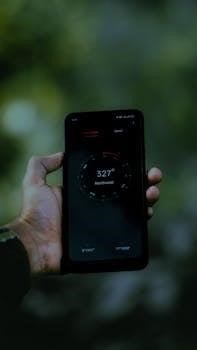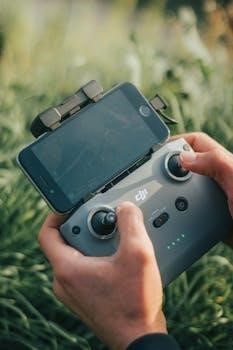
Welcome to the comprehensive user guide for the DJI Phantom 3 Standard. This guide provides essential information for operating your drone safely and efficiently. Here, you will find detailed instructions, helpful tips, and troubleshooting advice for your Phantom 3 Standard. Learn how to maximize your drone’s capabilities.
The DJI Phantom 3 Standard is a user-friendly quadcopter designed for aerial photography and videography. Released as a more accessible option within the Phantom 3 series, it offers a blend of performance and affordability. This drone is equipped with a 12-megapixel camera capable of capturing high-quality images and videos in 1520p, 720p, and 1080p resolutions. The Phantom 3 Standard is also designed with a gyroscope to enhance flight stability, making it suitable for both beginners and experienced users. It features a custom-built remote controller and an Intelligent Flight Battery, which provides up to 25 minutes of flight time. The drone weighs 1216 grams and utilizes Lithium Polymer (LiPo) battery technology. This guide will walk you through the various aspects of the Phantom 3 Standard, from its setup to its maintenance. The device also includes anti-drop pins to secure the gimbal and camera. It’s compatible with the DJI GO app, which enables easy control and monitoring of your drone. The Phantom 3 Standard is an excellent starting point for anyone interested in aerial photography and videography. Its ease of use and reliable performance make it a popular choice for capturing stunning aerial shots.
Key Features and Specifications
The DJI Phantom 3 Standard boasts several key features that make it a reliable and capable drone for aerial photography and videography. It includes a 12-megapixel camera, capable of recording video in 1520p, 720p, and 1080p formats, allowing for high-quality aerial footage. The drone’s megapixel range is approximately 12 MP, ensuring detailed images. The Phantom 3 Standard is equipped with a gyroscope, enhancing its stability during flight. This lightweight and durable device weighs 1216 grams, making it easy to transport. It utilizes a Lithium Polymer (LiPo) battery with a capacity of 4480 mAh, providing up to 25 minutes of flight time. The Intelligent Flight Battery is designed with smart charge and discharge functionality for safety. The drone comes with an 8 GB Micro SD card, but supports Micro SD cards up to 64 GB, recommending the use of UHS-1 or Class 6 for optimal performance. The Phantom 3 Standard is compatible with the DJI GO app, allowing for easy control and monitoring. It features a custom-built remote controller for precise navigation. It’s important to only use DJI certified propellers with this model. The drone is designed for easy operation, making it suitable for users of all experience levels. It balances performance and affordability, making it a great entry-level option for aerial enthusiasts.
Camera Capabilities and Video Modes
The DJI Phantom 3 Standard features a 12-megapixel camera designed for capturing high-quality aerial photos and videos. This camera is capable of recording video in multiple resolutions, including 1520p, 720p, and 1080p, offering versatility for different types of projects. The camera also supports various video modes, allowing users to capture footage that suits their specific needs, whether it’s for cinematic effects or simple recordings. The camera can be used in fully manual mode, giving users complete control over settings such as shutter speed and ISO, which is ideal for more advanced users seeking fine-tuned results. The ability to capture video at these various resolutions enables users to obtain high quality footage. This feature makes it suitable for both professional and recreational use, allowing for clear and detailed recordings. The camera is integrated into the drone’s gimbal system, which helps to stabilize footage, reducing the effects of vibration and motion during flight. The gimbal and camera are secured to the aircraft using Anti-drop Pins, which add another layer of safety. The camera’s capabilities are well-suited for aerial photography and filmmaking and with its range of video modes, the Phantom 3 Standard provides users with the tools they need to capture amazing aerial views.
Intelligent Flight Battery Information
The DJI Phantom 3 Standard utilizes an Intelligent Flight Battery with a capacity of 4480 mAh and a voltage of 15.2 V. This battery is designed with smart charge/discharge functionality, ensuring optimal performance and longevity. It is essential to use only the official DJI battery charger to charge the Intelligent Flight Battery, as using unauthorized chargers can cause damage or safety issues. The battery offers a flight time of approximately 25 minutes, enabling users to enjoy extended flights. The battery also undergoes testing before delivery, so a non-zero “Times Charged” value may appear in the DJI GO app even if the user has never used the battery. This is normal and the battery is safe to use. It takes 67 minutes to charge a battery with the Phantom 3 Professional charger, and 96 minutes with a Phantom 3 Advanced charger. To identify issues, refer to the Battery Level LEDs in the User Manual. It is crucial to follow all instructions for battery handling and charging provided in the user manual to maintain the battery in good working condition. The battery’s intelligent features also help manage power consumption, contributing to a safer and more reliable flying experience. Correct use of the battery is essential for maximizing its lifespan and ensuring the optimal performance of the DJI Phantom 3 Standard.
Micro SD Card Compatibility and Usage

The DJI Phantom 3 Standard comes with an 8 GB Micro SD card included, but it is also compatible with Micro SD cards having a capacity of up to 64 GB. For optimal performance when recording high-resolution photos and videos, it is recommended to use a UHS-1 or Class 6 Micro SD card to minimize delays during reading and writing of image files. Avoid inserting or removing the Micro SD card while the Phantom 3 Standard is powered on, as this can result in data loss or damage to the card. The Micro SD card is used to store all captured media, so it is critical to ensure the card is properly inserted before each flight. Regular formatting of the Micro SD card can help prevent issues with file storage. If the user is experiencing read or write speed issues, it may be an indication that a higher-class card is needed. Always make sure the card is formatted using a system compatible with the drone. The card should be handled carefully to avoid any damage to it or the drone’s card slot. Proper use of the Micro SD card ensures stable and reliable performance of the drone’s camera system during every flight.
Using the DJI GO App
The DJI GO app is an integral part of the Phantom 3 Standard experience, providing essential functionalities for controlling and monitoring your drone. This app allows you to view real-time video from the drone’s camera, adjust camera settings, and manage flight parameters. Through the app, you can initiate return-to-home functions, monitor battery levels, and view flight telemetry data. The DJI GO app also provides access to various intelligent flight modes, enhancing your drone’s capabilities. Before each flight, ensure the app is properly connected to your drone via Wi-Fi. The app also provides access to tutorial videos and other helpful resources for using the Phantom 3 Standard. It allows you to change camera settings, such as ISO, shutter speed, and video resolution. Additionally, you can use the app to manage firmware updates for your drone, ensuring optimal performance and stability. Regularly check for updates within the app, as these can provide important bug fixes and new features. The DJI GO app is crucial for an enjoyable and safe flying experience with your Phantom 3 Standard. It is essential to familiarize yourself with its interface and functions.

Understanding Remote Controller Functions
The remote controller for the DJI Phantom 3 Standard is your primary interface for piloting the drone. It features various controls that allow precise maneuvering and camera operation. The two control sticks manage the drone’s altitude, direction, and rotation. The left stick controls vertical ascent and descent and yaw, while the right stick manages forward/backward and left/right movement. The controller also includes buttons for taking photos and starting/stopping video recording. Additionally, there are toggle switches, specifically S1 and S2, that can be programmed for various functions. For instance, the S2 switch, when toggled, can initiate the Return to Home function. The S1 switch can be used to cancel this function. Familiarize yourself with these controls before your first flight to ensure safe and confident piloting. The controller also has LED indicators that display battery levels and connection status. It is important to ensure the controller is charged before each flight. The controller’s ergonomic design is intended for comfortable and precise operation. Understanding each of these functions is key to mastering the Phantom 3 Standard and maximizing your flight experience. Practice using the controls in a safe and open area before attempting more complex maneuvers.
Setting up and Preparing for First Flight
Before embarking on your first flight with the DJI Phantom 3 Standard, meticulous preparation is key to a safe and successful experience. Firstly, ensure that the Intelligent Flight Battery is fully charged using the official DJI charger. Inspect the propellers for any damage and securely attach them to the motors, ensuring they are correctly oriented. Next, insert a formatted Micro SD card into the designated slot, as this is where your aerial footage will be stored. Download and install the DJI GO app on your smartphone or tablet, which will serve as the primary interface for controlling the drone and viewing live camera feeds. Power on the remote controller and the Phantom 3 Standard. Pair the remote controller to the drone via the DJI GO app. Make sure your mobile device is connected to the drone’s Wi-Fi network. Calibrate the compass according to the instructions in the DJI GO app in an open area away from metal objects. Review the quick start guide for essential safety procedures. Choose an open, obstacle-free area for your first flight. With these preparations, you’re ready to begin your aerial adventures, step by step. Always prioritize safety.

Troubleshooting Common Issues
Encountering issues with your DJI Phantom 3 Standard is not uncommon, but most problems can be resolved with a systematic approach. If the drone fails to connect to the remote controller or the DJI GO app, ensure that both are fully charged and properly paired. Restarting both devices might resolve connection glitches. Should you experience unstable flight or drifting, recalibrate the compass and IMU in an open area away from magnetic interference. If the camera shows a blank screen or distorted images, check the Micro SD card for compatibility and ensure it is properly inserted. Verify that the gimbal is correctly installed and free from obstructions. Battery issues, such as not charging or not holding a charge, can sometimes be resolved by using the official DJI charger and ensuring the battery is not damaged. Errors during flight may be caused by firmware issues, so ensure that the firmware is up to date. Consult the DJI forum and user manual for more specific issues and solutions. If the problem continues, contact DJI support. With diligent troubleshooting, many common problems can be resolved efficiently.
Maintenance and Care
Proper maintenance and care are crucial to ensure the longevity and optimal performance of your DJI Phantom 3 Standard. Regularly inspect the drone for any signs of damage, such as cracks in the shell or loose screws. Clean the drone with a soft, dry cloth to remove dust and debris, avoiding the use of liquids or harsh chemicals. Pay special attention to the camera lens and gimbal, ensuring they are free from dirt. Store the drone in a dry and safe place when not in use, ideally in a hard case to prevent damage during transport. The Intelligent Flight Battery should be stored at around 50% charge and at room temperature to maintain its health. Avoid exposing the drone to extreme temperatures. Check and replace propellers if they are damaged or worn. Ensure that the firmware is kept up-to-date to ensure your drone is operating at its best. Regularly review the drone’s logs for unusual events and take the necessary steps to correct them. Following these maintenance steps will extend the life of your Phantom 3 Standard.
